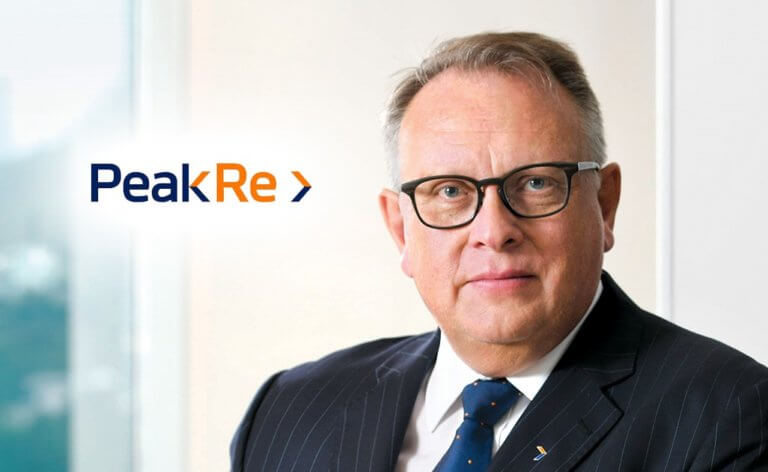SIRC: Much more to be done to convince capital markets — Peak Re’s Hahn
November 3 2023 by InsuranceAsia News
Despite a hardening market, the capital markets have yet to be convinced about the sustainability of the reinsurance market, according to Franz-Josef Hahn, chief executive of Peak Re.
“There’s still a huge uncertainty in the industry and the capital markets whether the industry can really continuously bring returns that are commensurate with the cost of capital. In the last seven years, there were not many years where capital costs were met by the reinsurance industry,” Hahn told InsuranceAsia News (IAN), on the sidelines of this year’s Singapore International Reinsurance Conference earlier this week.
Hong Kong-based Hahn explained: “The mid-year results of this year are a great encouragement, but they are only a drop on the hot stove, and they don’t yet move the dial for the capital markets.”
To be sustainable as an industry, much more has to be done. “Whether the level of pricing is adequate, we will see in the future, but certainly, the capital markets are not yet convinced”, according to Hahn.
There’s not much new capital that has entered the industry, Hahn said. “There is an additional 10% capital in the market this year but it went into alternative capital structures like ILS. The capital markets have been receiving much better yield for the cover they provide, and this is fair,” he said.
While globally, including in Asia Pacific, the prices need to go further up to address the growing frequency and severity of cat risks as well as inflation risks, the rising risk of unmodelled perils remains a key issue for the industry to address, said Hahn.
“A one-time underwriting adjustment to this phenomenon is not going to resolve the issue,” he added.
“We are looking at floods, torrential rains, or cloudbursts. There is a progression of losses racked up by these events, which won´t reverse as it is impacted by global warming.”
While 2023 may not have had single large events like Hurricane Ian last year, Hahn noted that medium-sized losses are creeping up.
“We had two large earthquakes, a number of floods starting with the Auckland flood and then Cyclone Gabriel shortly thereafter; we had a lot of floods in Europe from the north down to the South.
Italy was inundated three times this year. Spain had strong floods, southern France again”.
“I don’t know what the latest forecast for the year-end is, but in aggregation, it’s not a far cry from the previous years, specifically in flood losses,” he added.
The industry and governments need to think about how public-private partnerships can support better engineering of the cities and their risks and to protect urban centres against such floods, Hahn argued.
“How long can the reinsurance and insurance markets go on providing cover at affordable price? When does the situation kick in that reinsurers or the capital markets say that we don’t want to be in this any longer?”
“That would be a disaster, because in the end, insurance and reinsurance want to provide viable solutions for any kind of reasonable covers, and flood risk cover is a reasonable cover,” he said.
Governments, with the help of insurers, should work to mitigate the losses before it really hits the industry.
“We have capacity available for increasing our portfolio on a risk-adjusted basis.” Franz-Josef Hahn, Peak Re
1.1 renewals
Hahn said that renewals have started earlier this year. “In some areas discussions are ongoing including allocation of capital,” he said.
“We have capacity available for increasing our portfolio on a risk-adjusted basis,” Hahn said.
Peak Re, which reported losses in the last financial year, has been treading cautiously in the recent renewals, scripting financial turnaround, with this year’s first-half results posting record profit and robust combined ratios, on the back of careful risk selection and portfolio diversification.
“We were facing a dire situation in the third quarter of last year because of mark-to-market corrections as well as Hurricane Ian, when net asset values temporarily contracted at a time when business had to be renewed.
“We took that as an opportunity to reengineer the entire book,” he said on the Hong Kong reinsurer’s turnaround strategy.
“On the property side, we have been cutting sideways covers mainly, and with a few exceptions, we are not carrying any aggregate covers anymore.”
“We have been making it very clear that we don’t want to give sideways covers or dropdowns or free reinstatements in the future. We have been navigating further up in the excess of loss tower of the main program to reduce our exposure from unmodelled perils,” he said.
“We have not been radical in changing, we have been working together with our clients,” said Hahn adding, “I’m very proud to say that we hardly lost any of our clients. Instead, we took our clients along and weren’t standoffish like was in many other cases,” he added.

The market share of casualty and specialty lines in South-East Asia is relatively small compared to more traditional lines of insurance, such as property and motor insurance due to limited awareness and understanding and cost considerations.
Jasmine Miow, Peak Re
South-East Asian non-property lines ripe for substantive growth
Non-property lines, especially in specialty areas such as professional liability, directors and officers (D&O) liability, and cyber insurance, may have significant growth potential in South-East Asia, according to Jasmine Miow, director of South Asia and South-East Asia for Peak Re.
Reinsurers may find these lines attractive due to their potential for expansion and profitability in the region as South-East Asia is home to diverse and growing economies, which presents opportunities for insurers and reinsurers, she said.
“However, the market share of casualty and specialty lines in South-East Asia is relatively small compared to more traditional lines of insurance, such as property and motor insurance due to limited awareness and understanding and cost considerations,” Miow said.
“These lines often require a deeper understanding of specific risks and coverage needs. Many businesses and individuals may not be fully aware of the potential liabilities they face or the insurance solutions available to address them,” she added.
Specialty lines, such as professional liability or cyber insurance, can be relatively more expensive compared to standard property or motor insurance, Miow noted adding that cost considerations impact the uptake of these coverages, especially for smaller businesses or individuals with limited budgets.
However, there are drivers for the growth of casualty and specialty lines in South-East Asia.
“As businesses become more globally connected, regulatory requirements become more stringent, and awareness of specialised risks increases. Also, insurers and reinsurers are also actively developing and offering more tailored products to meet the evolving needs of businesses and individuals in the region,” she said.
Tapping the middle class
The rise of middle class in Asean offers opportunities in the market, driving economic growth, and increasing consumer spending, Miow said but pointed out that in-depth understanding of the regional difference is required in the region.
Miow said, citing a recent study by Peak Re, “While around a third of the middle class in Malaysia, Thailand, and Vietnam expect themselves to move upwards within the socioeconomic hierarchy over the next five years, the ratio was significantly higher at two-thirds in Indonesia. In the Philippines, half of the middle-class in aspire to become an entrepreneur or own a business, the ratio was closer to 20% in Malaysia and Vietnam.”
Increasing digitalisation and a higher readiness for emerging consumers to shop online is giving rise to new and innovative ways to distribute insurance in South-East Asia, she said.
“The rapid growth of digital ecosystems, which are increasingly tailored to the needs of consumers, growing internet penetration driven by improved infrastructure, affordability of smartphones, and availability of data plans. The booming of e-commerce markets and the rise of digital financial services” are some of the drivers in the region, according to Miow.
However, the region needs to streamline regulations and promote digitization that make it more viable to bundle insurance within the digital ecosystems’ channels.
“Regulatory sandboxes provide a conducive environment for insurance companies to experiment with innovative insurance products and distribution models. This enables insurers to partner with ecosystem players, such as ride-hailing platforms or e-commerce marketplaces, to offer insurance coverage directly within those platforms,” she noted.
-
PVI eyes Hanoi Re divestment plan as part of broader growth push
- July 15
In a wide-ranging interview, PVI Insurance chairman Duong Thanh Danh also talks to InsuranceAsia News about PetroVietnam Group's divestment plans, PVI's overseas partnerships, a US$1bn revenue target, growth opportunities and tariffs.
-
Ageas eyes deeper Asia presence with three-pronged approach to tried and tested model
- July 14
CEO Hans De Cuyper discusses the Belgian insurer’s strategic priorities in the region, the future of its Etiqa JV and how Taiping Re complements its reinsurance play.
-
New Australian MGA says collaboration key for D&O risks ‘no one else will touch’
- July 7
Collaboration Underwriting, headed by Alistair Sandilands, will target hard-to-place and broader D&O risks.
-
‘Asia is core to our strategy’: Swedish Club out to ‘broaden footprint’, with China and India on the radar
- June 27
Underwriting director Thorbjörn Emanuelsson also tells InsuranceAsia News about the challenges facing the P&I club, including the dark fleet and Donald Trump's tariffs.
-
Allianz General | Allianz General combines innovative protection solutions while powering social good to lead Malaysian market
The insurer proactively addresses emerging risks and evolving customer protection needs while giving back to the community.
-
Sedgwick | Asia’s Energy Transformation – Balancing Growth, Risk and Renewables
Energy market presents unique risks, especially in a region which includes China and Japan as well as developing nations like Vietnam and the Philippines.
-
Beazley | Turbulent Waters: the maritime energy transition challenge
Businesses are facing a complex transition to non-carbon energy sources amid a push to achieve net-zero emissions for the marine sector by 2050.
-
Aon | Navigating shifts in the global and Asia insurance markets
Neelay Patel, Aon head of growth for Asia, says the market in Asia is at an ‘interesting stage of the cycle’.

